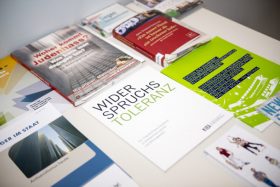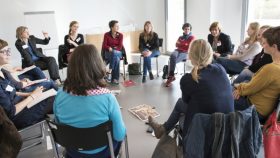Experts discuss political adult education on the Middle East conflict

Many educational providers offer materials for confronting anti-Semitism pedagogically; Jewish Museum Berlin, photo: Nadja Rentzsch
“Emotional” and “complex” are words often used to describe the Middle East conflict and approaches to it. How should it be handled in the everyday practice of education and continuing education? This is one of the questions in my research project “Didactics of the Middle East Conflict,” which I am conducting as a W. M. Blumenthal Fellow (more about the project on the museum website).
At a university or an institute, generally there is a research colloquium full of people working on similar themes, or who at least come from the same discipline. In such colloquia, one can present new work, discuss initial findings, get feedback about dealing with difficulties, and discover stimulating new ideas. At a museum, people engage with a great variety of topics, but not with empirical research on the didactics of the Middle East conflict. And so on September 8th, I invited external experts on educational work relating to the Middle East conflict, anti-Semitism, and racism to come to the museum. We discussed teaching and learning on this subject with members of the Education Department and the museum’s Academy Programs.
The participants have worked for many years (some of them as freelancers) in Berlin and elsewhere, with youth and adults in the field of anti-Semitism. Some of them have built educational organizations themselves to address the subject.
Continuing educational opportunities on the Middle East conflict often include modules on resentment and stereotypes surrounding Israel and its role in the conflict. Alongside the centuries-old anti-Semitic conception of a “Jewish power” in finance, the media, and world politics, new forms of anti-Semitism have sprung up. After the Shoah, anti-Semitism became a taboo, leading to so-called secondary anti-Semitism—for example, the assumption that Germany pays enormous sums in compensation to “the Jews” and to Israel. Another new form that expresses anti-Jewish resentment is anti-Semitism related to Israel. This form often finds a foothold in the Middle East conflict, so educational opportunities addressing it seem necessary.
The experts I invited believe that one of the greatest challenges is that the topic is so strongly charged, politically and morally. They’ve tried various methods of talking about and reflecting on the Israel-Palestine conflict, and about anti-Semitic sentiments, on the topical level as well as the emotional one. One initial hurdle is often that teachers and other professionals don’t envision themselves on the receiving end of educational processes. They only view continuing education as a sort of training that is supposed to improve their interactions with students and youth in recreational programs. But from the point of view of continuing education experts, thinking about one’s own associations and interest in the topic is the first step in this process. These are generally much more deeply seated than can be addressed by a discussion about lesson plans or problematic remarks by students.
Not infrequently, continuing education experts witness that in seminars, a silent majority forms, along with two diametric poles consisting of one or two people who portray the Israel-Palestine conflict live, as a struggle between good and evil. Anyone offering such educational opportunities must therefore come prepared with more than just well-developed moderating skills. An awareness of one’s own emotions and mental investment in the topic are also important. The guides at our museum will also face such high demands in the exhibition opening in December Welcome to Jerusalem (more about the exhibition on the website).
Our discussion also covered the significance of the location where such educational opportunities take place. In the participants’ experience, it’s not uncommon for such programs on modern-day anti-Semitism to begin at concentration camp memorial sites. This location is charged with feelings and meanings from the beginning, and it gives discussion of the conflict a strong moral sense. For open learning processes, that isn’t helpful. This is also a phenomenon common to the Jewish Museum Berlin, as in many ways it is perceived as a memorial site or as a sort of Jewish representative office.
Didactically reducing complexity belongs to the art of teaching and communicating in general. But the complexity and interwoven nature of the positions and circumstances in the Middle East conflict represent a particular challenge for continuing education experts as well as museum employees, especially because of the emotional intensity. Most of them see a certain imbalance in the fact that the positions and actions of many Arab nations and other nations are largely ignored—also in comparison to the discourse in other countries. However, they are and in the course of history were often much more powerful and capable of action than Palestinian figures. In German debates, the Middle East conflict seems to be reduced to the Israeli-Palestinian conflict, which appears to take place in a vacuum. This kind of opposition pushes discussions into a good/evil framework instead of moving beyond it.
Many further points were discussed in an extremely collegial atmosphere among external experts on education, us fellows, and the employees from the Educational Department and Academy Programs. A second meeting will certainly be arranged.
Dr. Rosa Fava started her Friday evening with great emotion because it was so easy to have a respectful, high-quality conversation about difficult topics .
